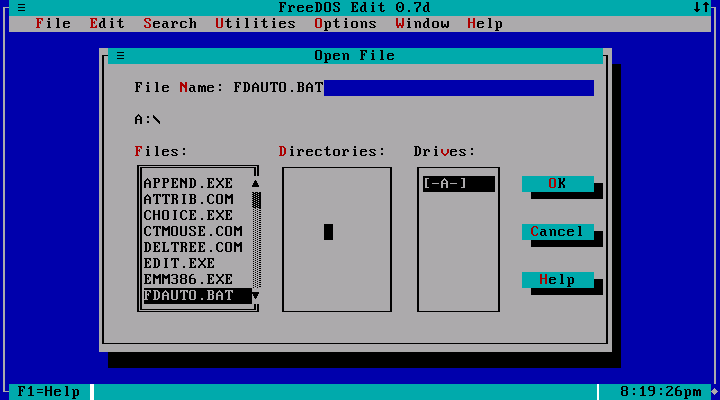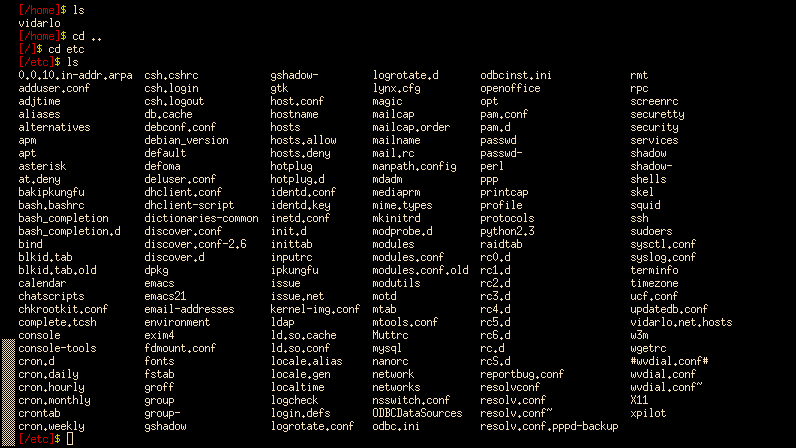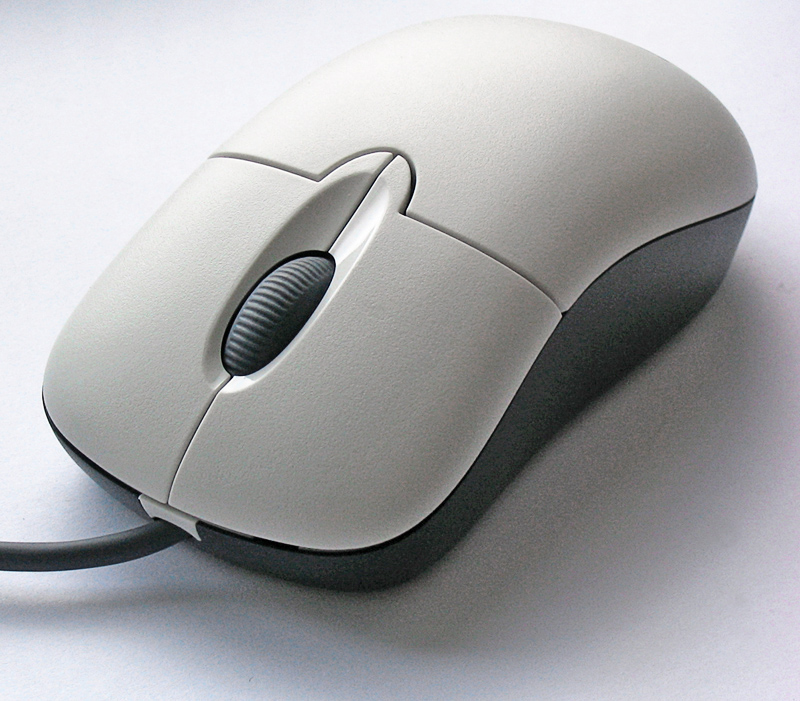|
Midnight Commander
GNU Midnight Commander (also known as mc, the command used to start it, and as mouseless commander in older versions) is a free cross-platform orthodox file manager. It was started by Miguel de Icaza in 1994 as a clone of the then-popular Norton Commander. GNU Midnight Commander is part of the GNU project and is licensed under the terms of the GNU General Public License. Design Midnight Commander is a console application with a text user interface. The main interface consists of two panels which display the file system. File selection is done using arrow keys, the insert key is used to select files and the function keys perform operations such as renaming, editing and copying files. Later versions of the Midnight Commander additionally have mouse support. Such versions are aware of GPM and X terminal emulators (such as GNOME Terminal or xterm) which support mouse reporting. When running inside an X terminal, these versions can update the name of the window in which Midn ... [...More Info...] [...Related Items...] OR: [Wikipedia] [Google] [Baidu] |
Ubuntu (operating System)
Ubuntu ( ) is a Linux distribution based on Debian and composed primarily of free and open-source software. Developed by the British company Canonical and a community of contributors under a meritocratic governance model, Ubuntu is released in multiple official editions: ''Desktop'', '' Server'', and ''Core'' for IoT and robotic devices. Ubuntu is published on a six-month release cycle, with long-term support (LTS) versions issued every two years. Canonical provides security updates and support until each release reaches its designated end-of-life (EOL), with optional extended support available through the Ubuntu Pro and Expanded Security Maintenance (ESM) services. , the latest stable release is 25.04 ("Plucky Puffin"), and the current LTS release is 24.04 ("Noble Numbat"). Ubuntu can be installed directly on hardware or run within a virtual machine. It is widely used for cloud computing, with integration support for platforms such as OpenStack. It is also one of the ... [...More Info...] [...Related Items...] OR: [Wikipedia] [Google] [Baidu] |
Text-based User Interface
In computing, text-based user interfaces (TUI) (alternately terminal user interfaces, to reflect a dependence upon the properties of computer terminals and not just text), is a retronym describing a type of user interface (UI) common as an early form of human–computer interaction, before the advent of bitmapped displays and modern conventional graphical user interfaces (GUIs). Like modern GUIs, they can use the entire Electronic visual display, screen area and may accept computer mouse, mouse and other inputs. They may also use color and often structure the display using box-drawing characters such as ┌ and ╣. The modern context of use is usually a terminal emulator. Types of text terminals From console application, text application's point of view, a text screen (and communications with it) can belong to one of three types (here ordered in order of decreasing accessibility): # A genuine text mode display, controlled by a video adapter or the central processor itself. ... [...More Info...] [...Related Items...] OR: [Wikipedia] [Google] [Baidu] |
FISH Protocol
A fish (: fish or fishes) is an aquatic, anamniotic, gill-bearing vertebrate animal with swimming fins and a hard skull, but lacking limbs with digits. Fish can be grouped into the more basal jawless fish and the more common jawed fish, the latter including all living cartilaginous and bony fish, as well as the extinct placoderms and acanthodians. In a break to the long tradition of grouping all fish into a single class (Pisces), modern phylogenetics views fish as a paraphyletic group. Most fish are cold-blooded, their body temperature varying with the surrounding water, though some large active swimmers like white shark and tuna can hold a higher core temperature. Many fish can communicate acoustically with each other, such as during courtship displays. The study of fish is known as ichthyology. The earliest fish appeared during the Cambrian as small filter feeders; they continued to evolve through the Paleozoic, diversifying into many forms. The earliest fish wi ... [...More Info...] [...Related Items...] OR: [Wikipedia] [Google] [Baidu] |
File Transfer Protocol
The File Transfer Protocol (FTP) is a standard communication protocol used for the transfer of computer files from a server to a client on a computer network. FTP is built on a client–server model architecture using separate control and data connections between the client and the server. FTP users may authenticate themselves with a plain-text sign-in protocol, normally in the form of a username and password, but can connect anonymously if the server is configured to allow it. For secure transmission that protects the username and password, and encrypts the content, FTP is often secured with SSL/TLS (FTPS) or replaced with SSH File Transfer Protocol (SFTP). The first FTP client applications were command-line programs developed before operating systems had graphical user interfaces, and are still shipped with most Windows, Unix, and Linux operating systems. Many dedicated FTP clients and automation utilities have since been developed for desktops, servers, mobile d ... [...More Info...] [...Related Items...] OR: [Wikipedia] [Google] [Baidu] |
Archive Format
In computing, an archive file stores the content of one or more computer file, files, possibly lossless compression, compressed, with associated metadata such as file name, directory structure, error detection and correction information, commentary, compressed data archives, storage, and sometimes encryption. An archive file is often used to facilitate software portability, portability, software distribution, distribution and backup, and to reduce computer storage, storage use. Applications Portability As an archive file stores file system information, including file content and metadata, it can be leveraged for file system content portability across heterogeneous systems. For example, a directory tree can be sent via email, files with unsupported names on the target system can be renamed during extraction, :v:File management#Time stamp preservation, timestamps can be retained rather than lost during data transmission. Also, transfer of a single archive file may be faster than pro ... [...More Info...] [...Related Items...] OR: [Wikipedia] [Google] [Baidu] |
RPM Package Manager
RPM Package Manager (RPM) (originally Red Hat Package Manager, now a recursive acronym) is a free and open-source package management system. The name RPM refers to the file format and the package manager program itself. RPM was intended primarily for Linux distributions; the file format is the baseline package format of the Linux Standard Base. Although it was created for use in Red Hat Linux, RPM is now used in many Linux distributions such as PCLinuxOS, Fedora Linux, AlmaLinux, CentOS, openSUSE, OpenMandriva and Oracle Linux. It has also been ported to some other operating systems, such as Novell NetWare (as of version 6.5 SP3), IBM's AIX (as of version 4), IBM i, and ArcaOS. An RPM package can contain an arbitrary set of files. Most RPM files are "binary RPMs" (or BRPMs) containing the compiled version of some software. There are also "source RPMs" (or SRPMs) containing the source code used to build a binary package. These have an appropriate tag in the file head ... [...More Info...] [...Related Items...] OR: [Wikipedia] [Google] [Baidu] |
Xterm
xterm is the standard terminal emulator for the X Window System. It allows users to run programs which require a command-line interface. If no particular program is specified, xterm runs the user's Unix shell, shell. An X display device, display can show one or more user's xterm windows input/output, output at the same time. Each xterm window is a separate Process (computing), process, but all share the same Computer keyboard, keyboard, taking turns as each xterm process acquires Focus (computing), ''focus''. Normally focus switches between X applications as the user moves the pointer (e.g., a mouse cursor) about the screen, but xterm provides options to ''grab focus'' (the ''Secure Keyboard'' feature) as well as accept input events sent without using the keyboard (the ''Allow SendEvents'' feature). Those options have limitations, as discussed in the xterm manual. XTerm originated prior to the X Window System. It was originally written as a stand-alone terminal emulator for ... [...More Info...] [...Related Items...] OR: [Wikipedia] [Google] [Baidu] |
GNOME Terminal
GNOME Terminal is a terminal emulator for the GNOME desktop environment written by Havoc Pennington and others. Terminal emulators allow users to access a UNIX shell while remaining on their graphical desktop. Features GNOME Terminal (gnome-terminal from the command line or GNOME's Alt-F2 launcher) emulates the xterm terminal emulator and provides some of the same features. Profiles GNOME Terminal supports multiple profiles. A user can create multiple profiles for their account. Users can then set configuration options on a per-profile basis and assign a name to each profile. The available configuration options range from different fonts, different colors, emission of the terminal bell, the behavior of scrolling, and how the terminal handles compatibility with the backspace and delete key. When GNOME Terminal starts, it can be configured to launch the user's default shell or run a custom command. These options can be configured per profile, allowing users to execute different co ... [...More Info...] [...Related Items...] OR: [Wikipedia] [Google] [Baidu] |
Terminal Emulator
A terminal emulator, or terminal application, is a computer program that emulates a video terminal within some other display architecture. Though typically synonymous with a shell or text terminal, the term ''terminal'' covers all remote terminals, including graphical interfaces. A terminal emulator inside a graphical user interface is often called a terminal window. A terminal window allows the user access to a text terminal and all its applications such as command-line interfaces (CLI) and text user interface (TUI) applications. These may be running either on the same machine or on a different one via telnet, ssh, dial-up, or over a direct serial connection. On Unix-like operating systems, it is common to have one or more terminal windows connected to the local machine. Terminals usually support a set of escape sequences for controlling color, cursor position, etc. Examples include the family of terminal control sequence standards that includes ECMA-48, ANSI X3.64, ... [...More Info...] [...Related Items...] OR: [Wikipedia] [Google] [Baidu] |
X Window System
The X Window System (X11, or simply X) is a windowing system for bitmap displays, common on Unix-like operating systems. X originated as part of Project Athena at Massachusetts Institute of Technology (MIT) in 1984. The X protocol has been at version 11 (hence "X11") since September 1987. The X.Org Foundation leads the X project, with the current reference implementation, X.Org Server, available as free and open-source software under the MIT License and similar permissive licenses. Purpose and abilities X is an architecture-independent system for remote graphical user interfaces and input device capabilities. Each person using a networked computer terminal, terminal has the ability to interact with the display with any type of user input device. In its standard distribution it is a complete, albeit simple, display and interface solution which delivers a standard widget toolkit, toolkit and protocol stack for building graphical user interfaces on most Unix-like operating syst ... [...More Info...] [...Related Items...] OR: [Wikipedia] [Google] [Baidu] |
GPM (software)
GPM ("General Purpose Mouse") software provides support for mouse devices in Linux virtual consoles. It is included in most Linux distributions. ncurses supports GPM; many applications use ncurses mouse-support. Other applications that work with GPM include Midnight Commander, Emacs, and JED. See also * moused, a mouse-driver for FreeBSD FreeBSD is a free-software Unix-like operating system descended from the Berkeley Software Distribution (BSD). The first version was released in 1993 developed from 386BSD, one of the first fully functional and free Unix clones on affordable ... Sources * External links * * Free system software Free software programmed in C Linux software {{Linux-stub ... [...More Info...] [...Related Items...] OR: [Wikipedia] [Google] [Baidu] |
Mouse (computing)
A computer mouse (plural mice; also mouses) is a hand-held pointing device that detects Plane (mathematics), two-dimensional motion relative to a surface. This motion is typically translated into the motion of the Cursor (user interface)#Pointer, pointer (called a cursor) on a computer monitor, display, which allows a smooth control of the graphical user interface of a computer. The first public demonstration of a mouse controlling a computer system was done by Doug Engelbart in 1968 as part of the Mother of All Demos. Mice originally used two separate wheels to directly track movement across a surface: one in the x-dimension and one in the Y. Later, the standard design shifted to use a ball rolling on a surface to detect motion, in turn connected to internal rollers. Most modern mice use optical mouse, optical movement detection with no moving parts. Though originally all mice were connected to a computer by a cable, many modern mice are cordless, relying on short-range rad ... [...More Info...] [...Related Items...] OR: [Wikipedia] [Google] [Baidu] |






